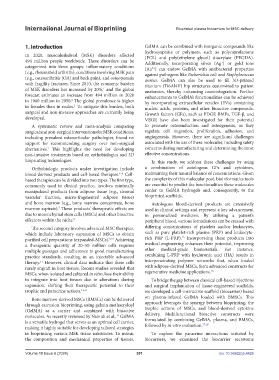Page 309 - IJB-10-6
P. 309
International Journal of Bioprinting Bioprinted plasma biocarriers for MSC delivery
1. Introduction GelMA can be combined with inorganic compounds like
hydroxyapatite or polymers, such as polycaprolactone
In 2020, musculoskeletal (MSK) disorders affected (PCL) and poly(ethylene glycol) diacrylate (PEGDA).
494 million people worldwide. These disorders can be Additionally, incorporating silver (Ag ) or gold ions
+
categorized into three groups: inflammatory conditions (Au ) can endow GelMA with antibacterial properties
3+
(e.g., rheumatoid arthritis), conditions involving MSK pain against pathogens like Escherichia coli and Staphylococcus
(e.g., osteoarthritis [OA] and back pain), and osteoporosis aureus. GelMA can also be used to fill 3D-printed
with fragility fractures. Since 2010, the economic burden titanium (Ti6Al4V) hip structures customized to patient
of MSK disorders has increased by 20%, and the global anatomies, thereby enhancing osseointegration. Further
1
forecast estimates an increase from 494 million in 2020 enhancements to GelMA’s functionalities can be achieved
2
to 1060 million in 2050. The global prevalence is higher by incorporating extracellular vesicles (EVs) containing
in females than in males. To mitigate this burden, both nucleic acids, proteins, and other bioactive compounds.
2
surgical and non-invasive approaches are currently being Growth factors (GFs), such as PDGF, BMPs, TGF-β, and
developed. VEGF, have also been investigated for their potential
A systematic review and meta-analysis comparing to promote osteoinduction and osteogenesis, as they
surgical and non-surgical interventions for MSK conditions, regulate cell migration, proliferation, adhesion, and
including prevalent osteoarticular pathologies, found no angiogenesis. However, there are significant challenges
support for recommending surgery over non-surgical associated with the use of these molecules, including safety
alternatives. This highlights the need for developing concerns during manufacturing and determining the most
3
non-invasive treatments based on orthobiologics and 3D effective concentrations.
bioprinting technologies. In this study, we address these challenges by using
Orthobiologic products under investigation include a combination of autologous GFs and cytokines,
blood-derived products and cell-based therapies. Cell- maintaining their natural balance of concentrations. Given
4–6
based therapies can be divided into two types. The first type, the complexity of this molecular pool, bioinformatics tools
commonly used in clinical practice, involves minimally are essential to predict the functionalities these molecules
manipulated products from adipose tissue (e.g., stromal confer to GelMA hydrogels and, consequently, to the
vascular fraction, micro-fragmented adipose tissue) bioprinted scaffolds.
and bone marrow (e.g., bone marrow concentrate, bone Autologous blood-derived products are extensively
marrow aspirate). These products’ therapeutic effects are used in clinical settings and represent a key advancement
7
due to mesenchymal stem cells (MSCs) and other bioactive in personalized medicine. By utilizing a patient’s
effectors within the niche. 8 peripheral blood, various formulations can be created with
The second category involves advanced MSC therapies, differing concentrations of platelets and/or leukocytes,
which include laboratory expansion of MSCs to obtain such as pure platelet-rich plasma (PRP) and leukocyte-
15
purified cell preparations (expanded-MSCs). Achieving rich PRP (L-PRP). Incorporating these products into
9,10
a therapeutic quantity of 20–50 million cells requires medical engineering enhances their potential, improving
multiple passages and adherence to good manufacturing other medical-grade biomaterials. For instance,
practice standards, resulting in an injectable advanced combining L-PRP with hyaluronic acid (HA) results in
therapy. However, clinical data indicate that these cells interpenetrating polymer networks that, when loaded
11
rarely engraft in host tissues. Recent studies revealed that with adipose-derived MSCs, form advanced constructs for
MSCs, when isolated and cultured in vitro, lose their ability regenerative medicine applications. 16
to integrate into host tissues due to alterations during To bridge the gap between classical cell-based injections
expansion, shifting their therapeutic potential to their and surgical implantation of tissue-engineered scaffolds,
trophic and paracrine actions. 12,13 we developed a cell-instructive scaffold (biocarrier) based
Bone marrow-derived MSCs (BMSCs) can be delivered on plasma-infused GelMA loaded with BMSCs. This
through extrusion bioprinting, using gelatin methacryloyl approach leverages the synergy between bioprinting, the
(GelMA) as a carrier and combined with bioactive trophic actions of MSCs, and blood-derived cytokine
molecules. As recently reviewed by Namidi et al., GelMA delivery. Multifunctional bioactive constructs were
14
is a versatile hydrogel that serves as an optimal cell carrier, formulated by combining GelMA, plasma, and BMSCs,
17,18
making it highly suitable for developing tailored strategies followed by in vitro evaluation.
in bioprinting various MSK tissue substitutes. To mimic To explore the paracrine interactions initiated by
the composition and mechanical properties of tissues, biocarriers, we examined the biocarrier secretome
Volume 10 Issue 6 (2024) 301 doi: 10.36922/ijb.4426

